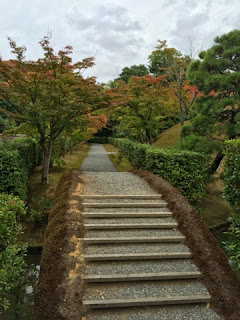I wanted to share with you another important garden in Kyoto that has had not only a big influence in Japan but also in the west.
In Asian terms, the garden is rather new having only been established in the mid 1600's.
 |
| Bamboo fencing is an art form in Kyoto and different knots and designs are almost like crests that belong to a certain shrine or temple. |
The garden that was visited by many foreign travelers and explorers that is often referred to in historical garden texts is the gardens of the Katsura Imperial Villa.
I started the tour from the beginning which is at the outside of the entrance.
The planting of the tree at the center is a way of being coy and not allowing the person to see the garden from one vantage point.
I started the tour from the beginning which is at the outside of the entrance.
The planting of the tree at the center is a way of being coy and not allowing the person to see the garden from one vantage point.
This garden is purely a stroll garden with the obligatory areas to enjoy tea but has no religious overtones and is simply an example of an aristocratic style in Japanese gardening.
This is one of the rare straight paths which is often avoided in Asian gardens because it doesn't engage the mind while walking but on an esoteric level it allows bad energy to travel easier.
Each stone was placed with purpose on this path.
The path leading to the tea house with the central vantage point.
Little islets with bridges leading to these mounds of earth has the most delightful effect.
Bridges symbolize connection and harmony.
What I love most about Japanese gardens is that a few steps along the path make all the difference to your view and perspective.
I was able to see a few more buildings on the other side of the lake once I passed the islets.
Standing in front of the tea house looking out at the view and then looking in.
The hole in the left next to the tatami mat was where pots of water would be boiled for tea.
The braided bamboo rattan sliding doors were originals and
I wish I could have gotten them made for my home but it is a dying and time consuming skill and therefore rather costly.
The blue and white color scheme is also original and quite unusual.
Normally one would have seen imagery of fortuitous symbols so it is rare to see something of this color palette and design.
The bridge has gravel on it to make people aware that either servants or guests are coming.
The Japanese take their stone paths seriously and this laying of stones is considered its own special talent and skill in gardening.
The garden let to other little huts that served as tea rooms and studies and the one you see below is the ode to the farmhouse that the members of the royal family would go to and pretend they were in a farming village.
Just behind the building still remain the vegetable growing fields that were purchased for the viewing pleasure rather reminiscent of
Marie Antoinette and her faux farm village.

Images of bridges are constant - must have been important symbols that served as a reminder to the family.
This is a shrine to a few members of the royal family.
This was one of the few rare garden flat lawns which served as a football pitch.
For those planning to visit, please note that you need to get admission approval from the Royal Household agency before hand and that the tour is in Japanese and all you will get is a pre recorded handset machine.
I hope you have a lovely weekend.
I am making this a no comments post as I am out this weekend and won't have proper time to reply.




























No comments:
New comments are not allowed.